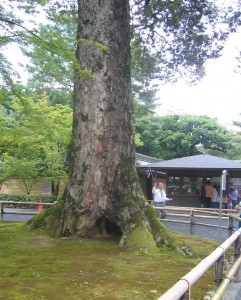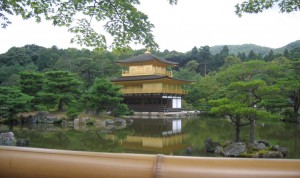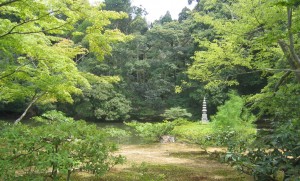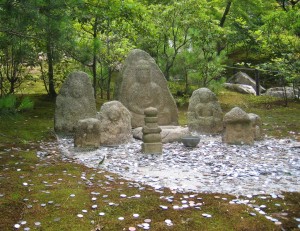It took a little longer to shake off the cobwebs this morning, a combination of getting used to the time zone and (more significantly) staying up too late last night. I didn’t have all morning to lie about, however, I needed to be fed and ready at 8:15, when the family was gathering to get our instructions for the trip to Kyoto. Thirty minutes later I had a number 16 affixed to my chest and we were on our way.
The trip started with a coach ride from the port of Kobe to Kyoto. The guide of coach 16 was a friendly fellow with lots of interesting stories about the little things that give a city its character. I didn’t hear all the stories; I was seated in the back, next to Obnoxious Italian Guy. The coach was full, and Obnoxious Italian Guy and his girlfriend simply needed more space than the seat provided. Not because they were big, but because he in particular was animated. He sat semi-sideways in the seat, using my shoulder as a back rest, and laughed and joked and waved his arms in a culturally-correct manner, and generally annoyed me. If I had said something he probably would have been quite all right with that; my quiet annoyance was probably just as culturally abrasive to him as his space-invading histrionics were to me.
In any case, we got to Kyoto. Our first stop was a Buddhist temple, built by a powerful Shogun and cousin of the Emperor. Before we got off the bus our guide showed the baton he would carry. At the end were two mini carp kites. “Follow the carp,” he said. He reminded us again when we were mustering after getting off the bus, where another tour guide was giving the same advice to her group, holding up an almost identical carp-festooned baton.
The place was was, as you might expect, beautiful. The most striking building was the golden Pavillion, a three-story structure. The upper two stories were covered in gilt which reflected in a still pond, while the ground floor was dark wood. “It is best when it is raining,” our guide said. He moved his hands to indicate a downpour. “When it is raining very hard. Then the upper part seems to be floating in the air. Very beautiful.” It was hot and humid; I hoped for rain, but no such luck.
We toured the grounds, pausing to hear stories of carp transforming into dragons and so forth. Almost right away my camera battery gave out. That was OK, I was surrounded by photographers. I concentrated on looking around.
All too soon we were done with the place, and I felt for the first time the downside of a group tour. We were in a place of quiet contemplation, a place designed explicitly to be a good place to sit and think (or not think). But, I was with forty other people and we had places to go. A tour can hardly schedule time for forty antsy tourists to stop for a moment, breathe, and feel the harmony of the surroundings permeate their own souls. We got back on the bus.
We drove past the Emperor’s Palace grounds, over the river where once thrived kabuki and brothels, to our next stop, a Shinto temple. We were instructed in the proper cleaning ritual, a symbolic preparation to enter the place and in itself a sort of prayer. I tried to get myself in the proper frame of mind as I washed left hand, right hand, mouth (cover your mouth when you spit the cleansing water back out – do not show God your teeth), then finally the handle of the water scoop, to make it ready for the next person.
Thus cleansed and in the proper frame of mind we entered the temple grounds. The buildings were massive and brightly painted. The place was a half-sized replica of the Emperor’s palace, which was burned down a century or four ago. Our group crunched over the white gravel of the grounds and approached the main shrine, which houses the spirits of not one but two great Emperors. We bowed respectfully, clapped, and made our wishes. (I did not wish for anything as base as a cooling rainstorm.) One can also purchase fortunes at the temple, not all of which are good. There are trees white with the fortune slips, as people who are not happy with their fortune will tie it to a branch and get a new one.
Back on the bus half an hour later and on to the next stop, a famous market street bursting with fresh seafood, intriguing snacks, enticing aromas, and the vibrant energy that any good market has. (Remind me to look up the name of this street.) Then it was back on the bus once again for a trip to a fancy hotel for a buffet lunch with dozens of dishes, from the familiar to the mysterious. I ate too much, trying to balance exotic and mundane. The afternoon included a visit to another, particularly cool temple perched on the hills overlooking the city, and time to shop in the streets that lead up to the temple.
I was feeling a powerful thirst, so I paused and drank a beverage called Pocasi Sweat (or something like that – “sweat” was in the name). It is what Gatorade used to be before it got sweet — a not-very-tasty-but-effective thirst quencher that replaces electrolytes. It was indeed refreshing.
Finally, we went to the train station and boarded the Shikansen (rhymes with ‘bullet train’) back from Kyoto to Kobe. According to fuego’s GPS-phone, we reached speeds of almost 280 km/h, the maximum the train is allowed to go in urban parts of the country. The trains don’t stop often and when they do it is not for long; we were warned by our guide that while the train would stop for almost two minutes in Kyoto, in Kobe we would have only a minute to get off. I think our huge group delayed departure a few seconds. Hopefully they were able to make up the time on the next leg.
Back in Kobe we boarded a different bus and were shuttled back to the boat, tired, pleased, and just a bit frazzled, considering all the places of peace and tranquility we had stampeded through. Better to stampede, though, than to not see it at all.






Part One of the Kyoto Trip:
http://sportstracker.nokia.com/nts/workoutdetail/index.do?id=1348416
pL
I remember the year that we lived in England, when we went to places that had lots of tourists arriving on coach (U.S. translation: bus) tours, the way the tourists could follow their guides was that the guides had umbrellas, and for the most part, the umbrellas were different colors.
I always wondered what would happen if more than one tour guide had the same color umbrella, or if it was raining and many of the tourists had their own umbrellas.
At least in Japan, most of the tourists are not likely to be carrying their own carp kites.
The tourists didn’t have carp, but a number of the tour guides all had the same two colored carp-on-a-stick setup. There was some potential for confusion, but only for a couple of the stops.
I really like your post, the way of the tourists could follow their guides was that the guides had umbrellas, and for the most part, the umbrellas were different colors……..it’s nice an…..
I love Kyoto. The food, people, curtule & historical building there are “authentic” as like you go back to ancient time of Nippon! I love that ice cream too! If not wrong it”s made of toufu !